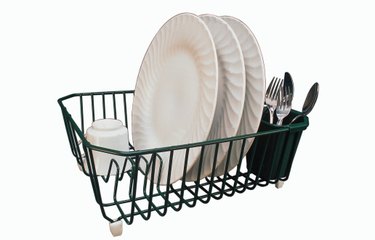Things You'll Need
Fine-steel wool pad
White vinegar
Kitchen towels
Drying rack
Olive oil
Paper towels
Paper plates

Pots and pans are frequently made of metal, leaving them susceptible to rust with prolonged exposure to moisture. Rust stains can be cleaned off most metal surfaces, especially cast iron. Once the rust is removed, care must be taken to ensure the cookware doesn't become rusty again. Rust stains that are left to develop and spread eventually move to other surfaces where they can deteriorate the surfaces to the point of being unusable.
Step 1
Inspect pots and pans carefully to ensure all rust has been removed. Even one tiny rust spot can develop into a full-blown rust problem. Dampen a steel wool pad with white vinegar and scrub any rust spots found to remove them.
Video of the Day
Step 2

Dry the pots and pans after removing rust and after each wash. Use a lint-free towel to remove moisture from the inside and outside of the cookware. Place rust-prone cookware face-down on a dish-drying rack to allow any remaining moisture to evaporate.
Step 3
Rub a quarter-sized amount of olive oil into iron pots and pans using a paper towel to cure the surface and prevent rust.
Step 4
Protect pots and pans in cupboards by placing one or two paper plates in between nestled cookware. This prevents unnoticed moisture from causing the pots and pans to become rusty while in storage.
Tip
Hang pots and pans in a rack over your kitchen island or above the stove range. Air circulation keeps them dry, which is the most important factor in preventing the return of rust.
Dry pots and pans immediately after washing by hand or in the dishwasher. Cookware left to sit in the dishwasher or drying rack without first being dried can develop rust in a short amount of time.
Video of the Day